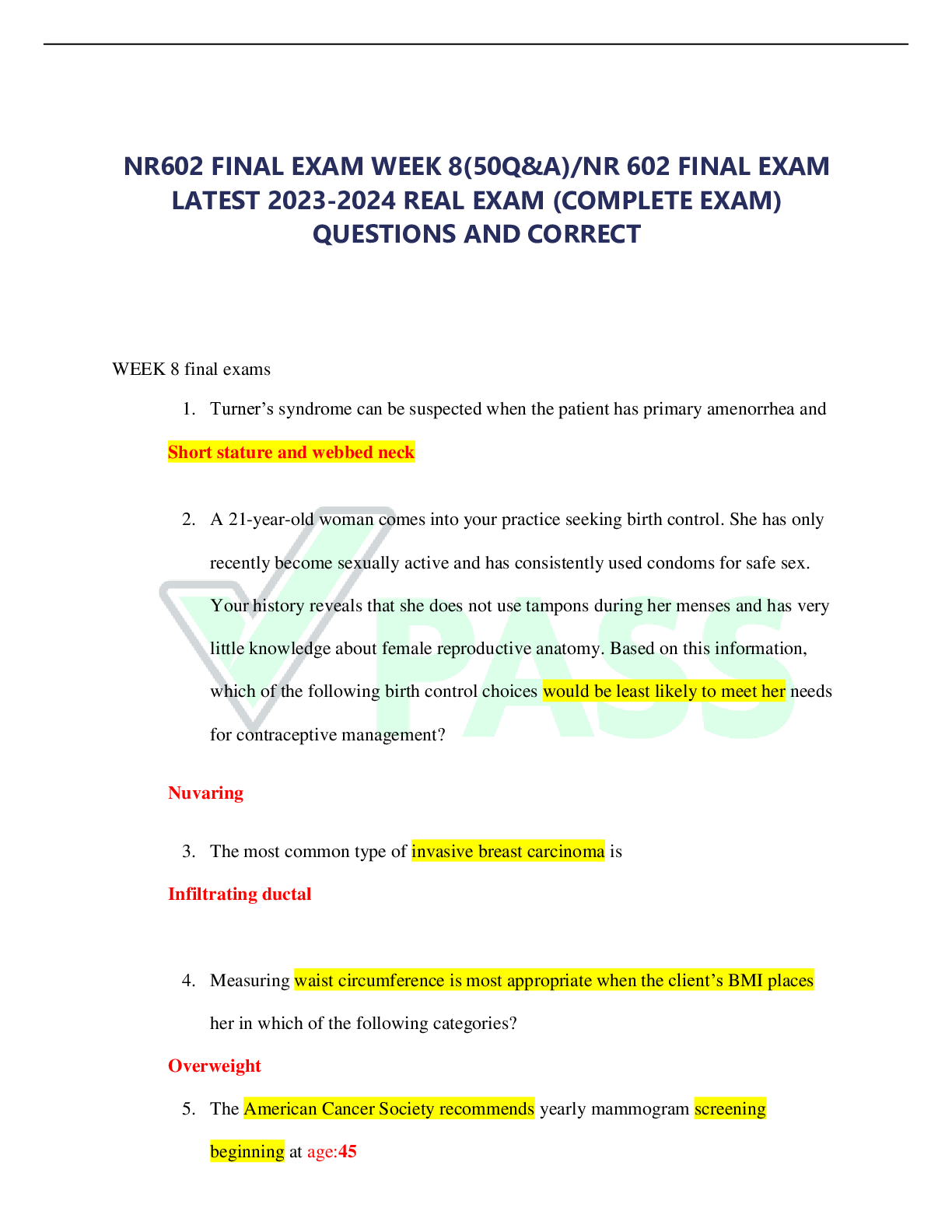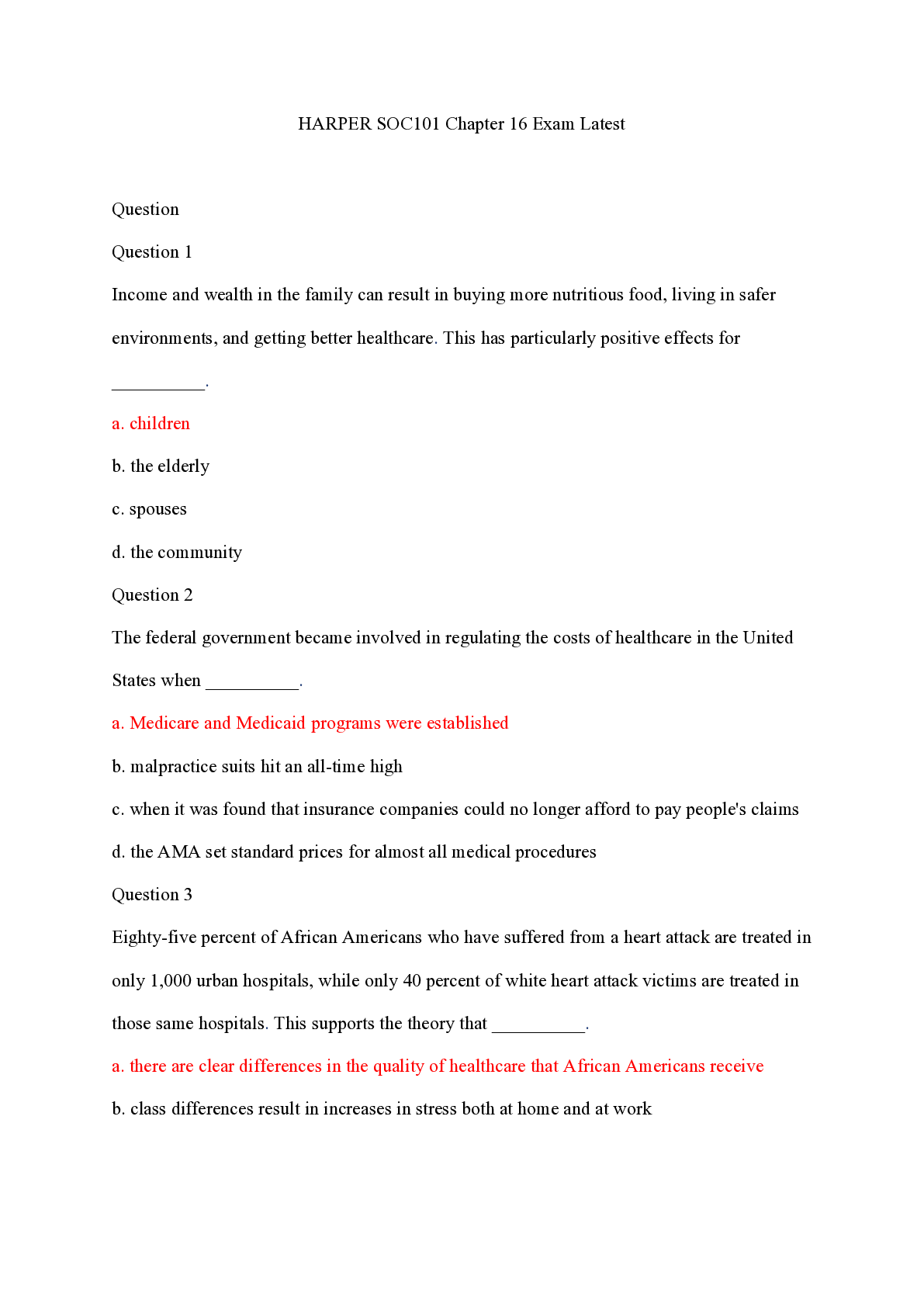*NURSING > EXAM > TEAS TEST 101 Chapter 16 exam (Spring 2020) | Human Anatomy & Physiology_The Endocrine System (All)
TEAS TEST 101 Chapter 16 exam (Spring 2020) | Human Anatomy & Physiology_The Endocrine System
Document Content and Description Below
TEAS TEST 101 Chapter 16 exam (Spring 2020) – St. Augustine College (A Grade) Human Anatomy & Physiology, 10e (Marieb) Chapter 16 The Endocrine System 16.1 Matching Questions Figu... re 16.1 Using Figure 16.1, match the following: 1) Produces the hormones that promote the development of the female secondary sexual characteristics at puberty. D-Ovaries 2) Storehouse for the hormones produced by the hypothalamus of the brain. B-Pituitary Gland 3) Produces the hormones that direct the production of the secondary male sex characteristics. E-Testis 4) Produce hormones involved in electrolyte balance and the stress response. C-Adrenal Gland 5) Produces hormones and is considered a neuroendocrine organ. A-Hypothalamus Figure 16.2 Using Figure 16.2, match the following anterior pituitary hormones with their targets: 6) Growth hormone. A 7) Follicle stimulating hormone. C 8) Prolactin. B 9) Adrenocorticotropic hormone. Corticotropin-releasing CRH E 10) Thyroid stimulating hormone. Thryotropin releasing TRH D Match the following: A) Addison's disease B) Diabetes mellitus C) Graves' disease D) Acromegaly E) Pituitary dwarfism 11) An autoimmune problem involving the thyroid gland. C 12) Hyposecretion of growth hormone. E 13) Hyposecretion of the pancreas. B 14) Hyposecretion of the adrenal cortex. A 15) Hypersecretion of growth hormone. D Match the following: A) Myxedema B) Cushing's disease (Acromegaly) C) Gigantism D) Cretinism 16) Hyposecretion of the thyroid in adults. A 17) Hypersecretion of the adrenal cortex. D 18) Hypersecretion of growth hormone. B 19) Hyposecretion of the thyroid in infants. C Match the following: A) Thyroid gland B) Pancreas C) Pituitary gland (hypophysis) D) Adrenal medulla E) Parathyroid glands 20) The size and shape of a pea; produces hormones that stimulate other endocrine glands. C 21) Is part of the sympathetic (fight or flight) nervous system. D 22) Produces hormones that regulate glucose levels in the body. B 23) Primary regulators of blood calcium levels. E 24) Produces the body's major metabolic hormones. A Figure 16.3 Using Figure 16.3, match the following: 25) Mainly produces glucocorticoids. B 26) Produces epinephrine. D 27) Produces aldosterone. A 28) Excess hormone levels from this region result in Cushing's syndrome. A 29) Hormones mimic sympathetic nervous system neurotransmitters. D 30) Mainly produces small amounts of gonadocorticoids. C Match the following: A) Neural stimulus B) Hormonal stimulus C) Humoral stimulus 31) Testosterone production. B 32) Epinephrine production. A 33) Aldosterone production. B 34) Parathyroid hormone production. C 16.2 True/False Questions 1) The pineal gland is used as a brain orientation landmark for brain X rays. True 2) Calcitonin is the main regulator of blood calcium levels. (The antagonistic hormones that regulate the blood calcium level are calcitonin parathormone) True 3) The hormone that raises blood sugar levels is insulin. - - - - - - - Continued [Show More]
Last updated: 2 years ago
Preview 1 out of 13 pages
 – St.png)
Buy this document to get the full access instantly
Instant Download Access after purchase
Buy NowInstant download
We Accept:

Reviews( 0 )
$12.50
Can't find what you want? Try our AI powered Search
Document information
Connected school, study & course
About the document
Uploaded On
Mar 04, 2021
Number of pages
13
Written in
Additional information
This document has been written for:
Uploaded
Mar 04, 2021
Downloads
0
Views
111








 – University of the People.png)








.png)



